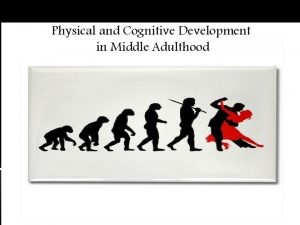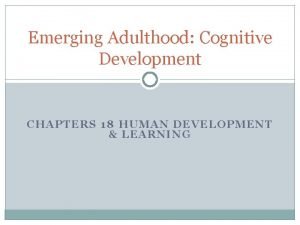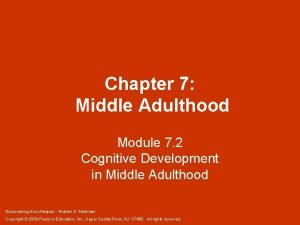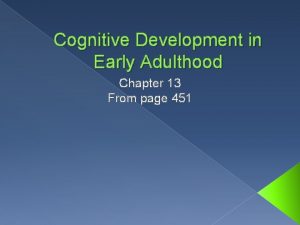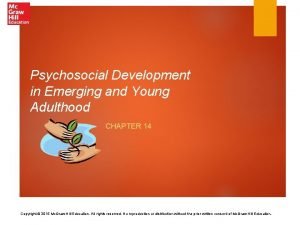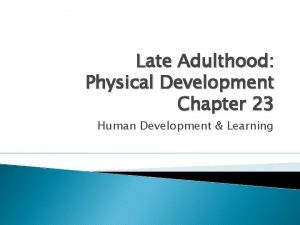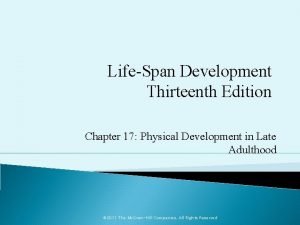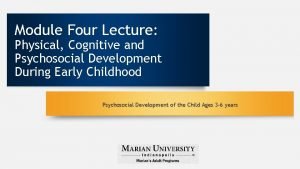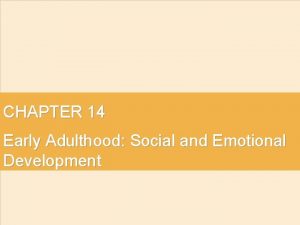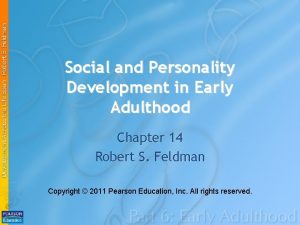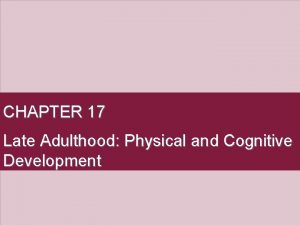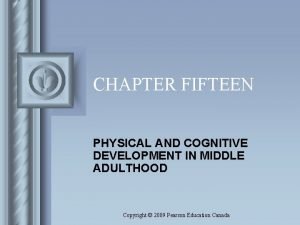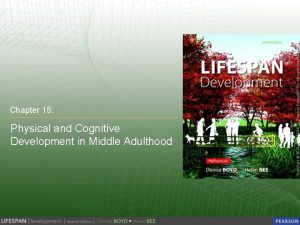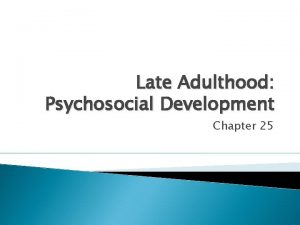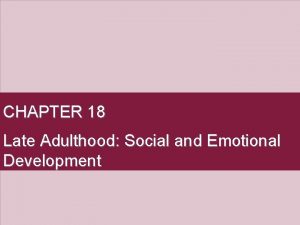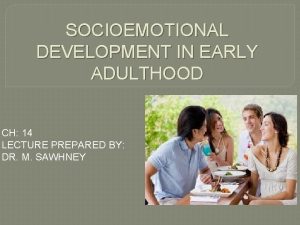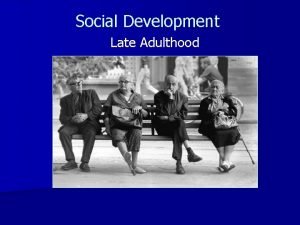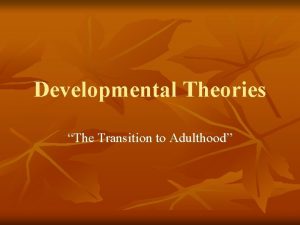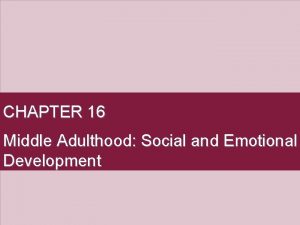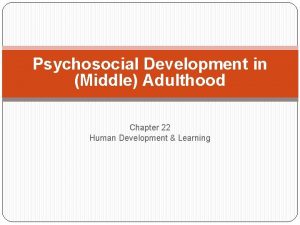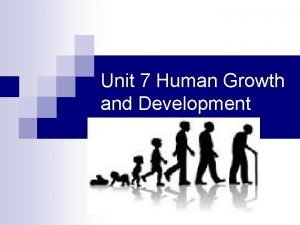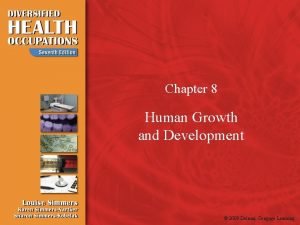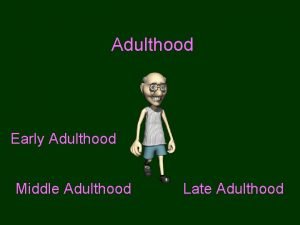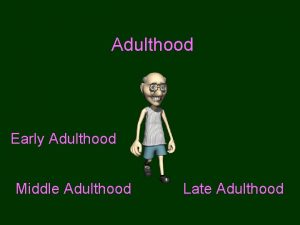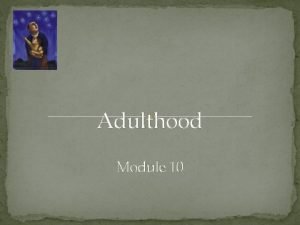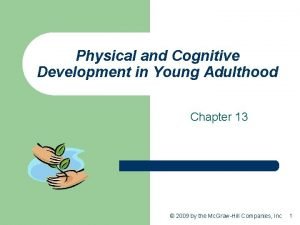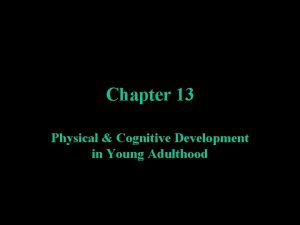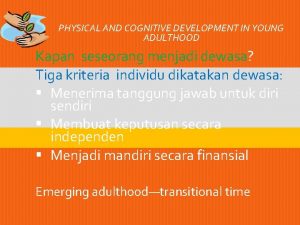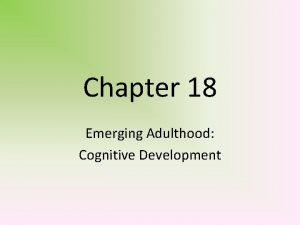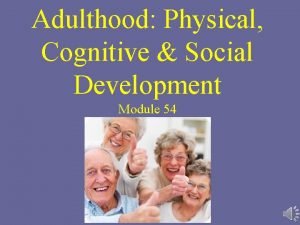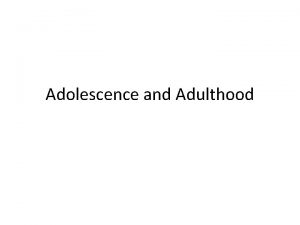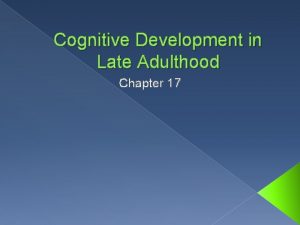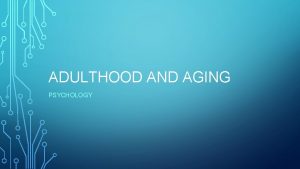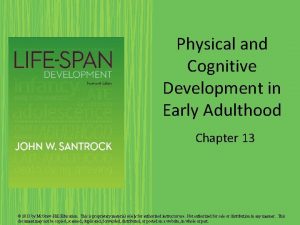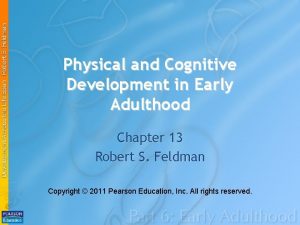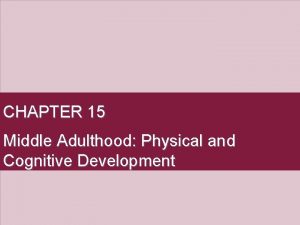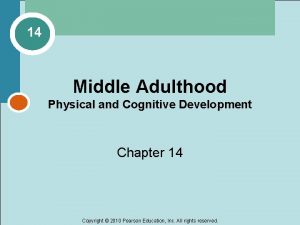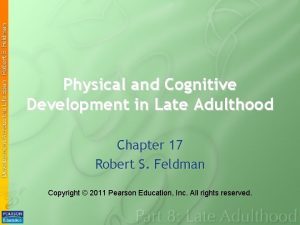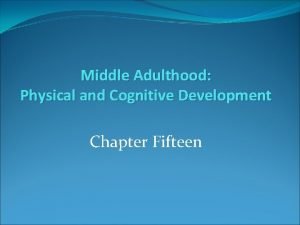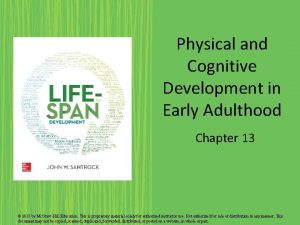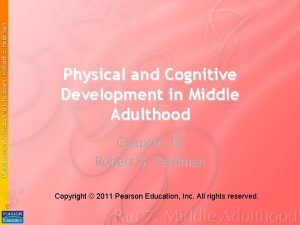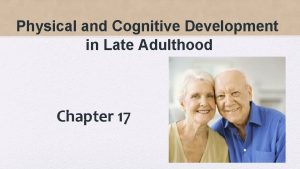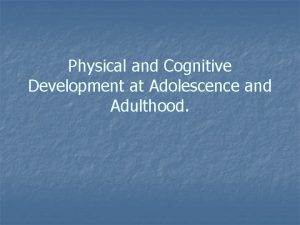12 Young Adulthood Physical and Cognitive Development Chapter




































- Slides: 36

12 Young Adulthood Physical and Cognitive Development Chapter 12 Copyright © 2010 Pearson Education, Inc. All rights reserved.

Young Adulthood Physical and Cognitive Development • Perspectives on Adult Development • General Physical Development • Sex and Sexuality • Cognitive Development in Adulthood • Frameworks for Understanding Adult Development Copyright © 2010 Pearson Education, Inc. All rights reserved.

Perspectives on Adult Development • Many key events are normative, occurring at predictable times for most people in an age cohort • Idiosyncratic events are not anticipated and generally cause stress and readjustment Copyright © 2010 Pearson Education, Inc. All rights reserved.

Perspectives on Adult Development • Age Clocks and Social Norms – age clock: our internal sense of time for when major life events are supposed to occur – influenced by cultural factors and more flexible today than in times past • Three Components of Age – biological age: physiological perspective – social age: one’s status compared to cultural norms – psychological age: one’s ability to adapt to social and environmental demands Copyright © 2010 Pearson Education, Inc. All rights reserved.

Perspectives on Adult Development • Contextual paradigms – examine effect of multiple factors interacting together that influence adult development – Contextual approaches are complex, but contextual considerations become very important in young adulthood Copyright © 2010 Pearson Education, Inc. All rights reserved.

General Physical Development • Strength and Stamina – Peak time for vitality, strength, and good health, as most biological systems begin to decline in the 30 s and 40 s • Fitness and Health – peak performance in physical abilities – leading cause of death in early adulthood is accidents – men three times as likely as women to die from accidents – Other diseases that may cause later problems may begin at this time (e. g. , heart disease) Copyright © 2010 Pearson Education, Inc. All rights reserved.

Average Declines in Biological Systems SOURCE: Adapted from Vitality and aging, by J. Fries and Crapo, 1981. San Francisco: W. H. Freeman. Copyright © 2010 Pearson Education, Inc. All rights reserved.

Percent of U. S. Population Reporting Weekly Physical Activity, 2006 SOURCE: From Health, United States, 2007 with chartbook on trends in the health of Americans. Hyattsville, MD: National Center for Health Statistics. Copyright © 2010 Pearson Education, Inc. All rights reserved.

General Physiology Across Lifespan for Active and Sedentary Persons SOURCE: From Figure 11. 5, in Lifelong motor development, by C. P. Gabbard, 2004 ( p. 368). Upper Saddle River, NJ: Pearson Education. Reprinted by permission. Copyright © 2010 Pearson Education, Inc. All rights reserved.

Major Causes of Death in United States, 2005, for Youths, Ages 15– 24 SOURCE: From Health, United States, 2007 with chartbook on trends in the health of Americans, Vol. 53. Hyattsville, MD: National Center for Health Statistics. Copyright © 2010 Pearson Education, Inc. All rights reserved.

Major Causes of Death in United States, 2005, for Young Adults, Ages 25– 44 SOURCE: From Health, United States, 2007 with chartbook on trends in the health of Americans, Vol. 53. Hyattsville, MD: National Center for Health Statistics. Copyright © 2010 Pearson Education, Inc. All rights reserved.

Sex and Sexuality • Fertility – Women’s fertility declines after age 38 and ends with menopause – Men remain fertile from puberty on • Sexually Transmitted Diseases – HIV/AIDS – Chlamydia – Gonorrhea – Herpes – Syphilis Copyright © 2010 Pearson Education, Inc. All rights reserved.

Video Clip CNN report on rising STD rates and the disproportionate effects on women and minorities: http: //www. cnn. com/video/#/video/health/2009/01/1 3/cohen. std. rates. up. cnn Copyright © 2010 Pearson Education, Inc. All rights reserved.

Video Clip CNN report on rising rates of HIV/AIDS in Washington D. C. : http: //www. cnn. com/video/#/video/politics/2009/03/ 17/verjee. aids. report. cnn Copyright © 2010 Pearson Education, Inc. All rights reserved.

Video Clip Overview of the AIDS epidemic in Africa from the video Hope in the time of AIDS: http: //www. youtube. com/watch? v=mog. Twwepces Copyright © 2010 Pearson Education, Inc. All rights reserved.

Sexual Attitudes and Behaviors • Since the 1970 s, sexual attitudes and behavior have continued to shift • Most U. S. adults are monogamous • Three patterns of sexual relations • Married couples have the most sex and are most likely to have orgasms during sex • Only minor variations in sexual activity across ethnic groups • People in 20 s and 30 s report highest frequencies of sexual activity Copyright © 2010 Pearson Education, Inc. All rights reserved.

Sexual Identity and Orientation • Realizing an attraction to one’s own sex is often accompanied by a self-questioning process • Gay, lesbian, and bisexual persons often experience social prejudice and discrimination • Sexual orientation is a complex interaction of heredity and environment • Sexual orientation is not “either-or, ” but exists along a continuum • Homophobia is prejudice, aversion, fear, or negative attitudes directed toward persons of same-sex orientation Copyright © 2010 Pearson Education, Inc. All rights reserved.

Video Clip Excerpt from 60 Minutes nature vs. nurture sexual orientation debate: http: //www. youtube. com/watch? v=_Osw 05 HGe 5 I& feature=Play. List&p=75 A 12 E 1782 A 4 D 814&playnex t=1&playnext_from=PL&index=23 Copyright © 2010 Pearson Education, Inc. All rights reserved.

Three Measures of Sexual Satisfaction with Primary Partner SOURCE: Figure 9, “Three measures of sexual satisfaction with primary partner, ” From Sex in America, by R. T. Michael, E. O. Laumann, and G. Kolata, copyright ゥ 1994 by CSG Enterprises, Inc. By permission of Little, Brown and Co. , Inc. , and Brockman, Inc. Copyright © 2010 Pearson Education, Inc. All rights reserved.

A Continuum Approach for Understanding Sexual Orientation Copyright © 2010 Pearson Education, Inc. All rights reserved.

Demographics of Same-Sex Orientation SOURCE: Table, from The social organization of sexuality, by Laumann, Gagnon, Michael, and Michaels, Copyright ゥ 2004. Reprinted by permission of the University of Chicago Press. Copyright © 2010 Pearson Education, Inc. All rights reserved.

Cognitive Development in Adulthood • Cognitive skills involving response speed and rote memory are at their peak • Some researchers suggest adults reach a level of cognitive development beyond Piaget’s formal operations stage, that of dialectical thought – Includes being able to consider ambiguous situations, involves judgment and decision making • Postformal thought is heavily contextualized and includes social, interpersonal, cognitive, and emotional aspects Copyright © 2010 Pearson Education, Inc. All rights reserved.

Cognitive Development • Emotional intelligence (EQ) – Aspects of the intellect that relate to the way people manage their own and others’ emotions and emotional responses • Schaie’s concept of cognitive flexibility – The ability to use intelligence in different ways during different periods throughout the lifespan Copyright © 2010 Pearson Education, Inc. All rights reserved.

Goleman’s Four Areas of Emotional Intelligence Copyright © 2010 Pearson Education, Inc. All rights reserved.

Schaie’s Life-Span Model of Cognitive Development Copyright © 2010 Pearson Education, Inc. All rights reserved.

Frameworks for Understanding Adult Development • Stages and Contexts – The stage approach is the idea that we all progress through stages in an orderly way; specific life events play relatively minor roles – Context models focus on the specific experiences in one’s life • Havighurst’s Developmental Tasks – Adulthood consists of three periods during which a series of tasks must be accomplished Copyright © 2010 Pearson Education, Inc. All rights reserved.

Havighurst’s Developmental Tasks Copyright © 2010 Pearson Education, Inc. All rights reserved.

Frameworks for Understanding Adult Development • Erikson – Young adulthood is the age of intimacy versus isolation – Resolution in each stage rests on the preceding stages • Levin – Identified three major eras in the male life cycle – Women experience adult development much the same way as men, but the tasks are different Copyright © 2010 Pearson Education, Inc. All rights reserved.

Levin’s Developmental Tasks for Man’s Entry Into Adulthood Copyright © 2010 Pearson Education, Inc. All rights reserved.

Comparison of Men’s and Women’s Entry into Careers (Levinson) Copyright © 2010 Pearson Education, Inc. All rights reserved.

Frameworks for Understanding Adult Development • Normative Models – organized around major life events – reflect the experiences of culture and gender – less useful in times of rapid cultural change or when people have multiple roles • Gould’s model focuses more on cognitive view than social changes – Adults of different ages look at the world differently. Copyright © 2010 Pearson Education, Inc. All rights reserved.

Gould’s Transformations in Early Adulthood Copyright © 2010 Pearson Education, Inc. All rights reserved.

Frameworks for Understanding Adult Development • Limitations of stage theories of adult development – They tend to ignore the uniqueness of individual lives – They undervalue the interactive nature of multiple contexts – They often reflect the values and experiences of a particular cohort group Copyright © 2010 Pearson Education, Inc. All rights reserved.

Selected Theorists’ Views of Major Tasks of Early Adulthood Copyright © 2010 Pearson Education, Inc. All rights reserved.

Summary • Compared to earlier periods, changes in adulthood are less predictable and individuals vary more in the paths their lives take • Age is a complex concept that represents biolgoical, social, and psychological age • Most people enjoy peak vitality, strength, and good health systems during young adulthood, with peak performance in many physical abilities occurring in the decade of the 20 s • The leading cause of death at this age is accidents Copyright © 2010 Pearson Education, Inc. All rights reserved.

Summary • Early adulthood is the time during which people are most sexually active • STDs affect millions of young adults • Sexual orientation issues may emerge • Cognitive skills are at their peak in early adulthood, and cognitive flexibility is apparent • Postformal thinking, which is highly contextualized, may be manifest at this time • Social and emotional intelligence may enhance young adult cognition Copyright © 2010 Pearson Education, Inc. All rights reserved.
 Cognitive development in early adulthood
Cognitive development in early adulthood Physical changes during early adulthood
Physical changes during early adulthood Early adulthood milestones
Early adulthood milestones Cognitive development in middle adulthood
Cognitive development in middle adulthood Late adulthood cognitive development
Late adulthood cognitive development Cognitive development in emerging adulthood
Cognitive development in emerging adulthood Cognitive development in middle adulthood
Cognitive development in middle adulthood Commitment within relativistic thinking
Commitment within relativistic thinking Emerging adulthood psychosocial development
Emerging adulthood psychosocial development Middle adulthood physical development
Middle adulthood physical development Late adulthood physical changes
Late adulthood physical changes Physical development in late adulthood
Physical development in late adulthood Adulthood development stages
Adulthood development stages Define physical cognitive and psychosocial development
Define physical cognitive and psychosocial development Cognitive and non cognitive religious language
Cognitive and non cognitive religious language Chapter 5 cognitive development in infancy and toddlerhood
Chapter 5 cognitive development in infancy and toddlerhood Slidetodoc. com
Slidetodoc. com Social changes in middle adulthood
Social changes in middle adulthood Social and emotional development in adulthood
Social and emotional development in adulthood Personality development in early adulthood
Personality development in early adulthood Social and emotional development in late adulthood
Social and emotional development in late adulthood Early childhood is ____ for language learning
Early childhood is ____ for language learning Physical changes in late adulthood
Physical changes in late adulthood Denny's model of physical and cognitive ageing
Denny's model of physical and cognitive ageing Denny's model of physical and cognitive ageing
Denny's model of physical and cognitive ageing Late adulthood psychosocial development
Late adulthood psychosocial development Social development in adulthood
Social development in adulthood Late adulthood emotional development
Late adulthood emotional development Socioemotional development in early adulthood
Socioemotional development in early adulthood Disengagement theory
Disengagement theory Klaus riegel theory
Klaus riegel theory Middle adulthood social changes
Middle adulthood social changes Permaparenting
Permaparenting Emotional development in late adulthood
Emotional development in late adulthood Chapter 8:1 life stages
Chapter 8:1 life stages Late childhood cognitive development
Late childhood cognitive development Ap psych schema
Ap psych schema



